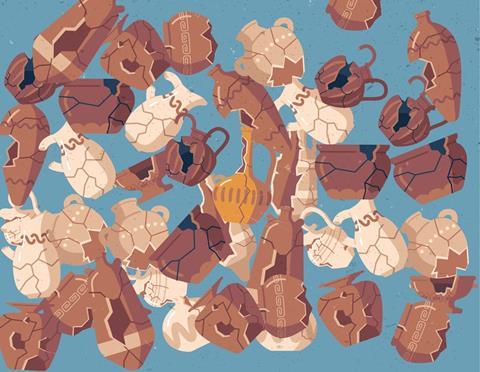Throughout Christian history, those at the bottom of society have been most receptive to the good news, explains David Instone-Brewer

Plastic, a non-biodegradable waste, is one of the scourges of the modern world. In New Testament times, it was pottery sherds – bits of broken pots, vases and crockery. They were everywhere – kicked into ditches, thrown over neighbours’ fences (no one was paid to pick up litter) – and they lasted forever.
Of course, for archaeologists, sherds help with dating, and perhaps our plastic trash will have some value to future archaeologists as they distinguish between today’s take-away boxes, 1960s Tupperware and 1930s Bakelite wireless cases.
But pottery sherds did have another practical use: they were a convenient medium to write on. A sherd that is found to have been used in this way is so valuable to scholars that it has a special name – an ‘ostracon’.
Most ostraca that have been found just contain names. If you were in the baths and there was no slave to look after your clothes, you could leave a sherd with your name on it. Or instead of waiting in a queue to get your grain weighed, you could write your name on a sherd and place it on top of your basket or sack.
The potter’s field where Judas killed himself, later bought with his 30 coins, may have originally belonged to a potter, but the name was likely to have been a polite way of saying it was full of refuse – the place where fly-tippers dumped their waste. It all rotted away, except for the pottery, and this made it an unfarmable wasteland.
Old pottery was an especially huge problem in Rome, where a million inhabitants bought imported oil and wine in pottery flagons from all over the empire. Wine flagons might have been used again for poorer quality wine, but oil jars couldn’t be reused because the oil seeped into the pottery and went rancid, tainting the flavour of anything inside. So they were just smashed and trashed.
Dark places
A gargantuan mound of broken pottery gradually grew near the port of Rome. Today, it is still more than 100ft high and half a mile in circumference. The district is now named after it: Testaccio (testae is Latin for ‘sherd’). It became famous for the excellent wine cellars formed by tunnelling into the mound, which has natural cooling qualities.
This was the poor part of town, where sailors got drunk and trash from the ships piled up. The offal market is still there, evidence of a subsistence diet that is now chic, and, nowadays, the area is celebrated for its restaurants, which are actually built into this huge pile of broken pottery.
The restaurant my family visited lined its inside walls with glass, so visitors can see the ancient pottery that kept customers cool long before air conditioning was invented. After the meal, my wife and I sampled the wine while our young adult daughters went out to explore the area. A worried waiter asked where they were and explained that it is still somewhat of a red-light area. We left quickly to find them!
Early Christians sought out places like this and many sinners were converted as a result. When he addressed the Corinthian church, Paul said of “the sexually immoral” that they “will not inherit the kingdom of God” and then added: “And that is what some of you were” (1 Corinthians 6:9-11). As a result of sharing the gospel in such places, believers were derided as “the scum of the earth, the garbage of the world” (1 Corinthians 4:13).
The gospel spread first among slaves in the Roman Empire. The earliest church leaders we know of, outside the New Testament, were two women who were arrested by Pliny the Younger in AD 112. The fact that they were tortured, even though they had already confessed to being Christians, indicates they were slaves.
Disreputable
Throughout Christian history, those at the bottom of society have been most receptive to the good news. In India, the gospel didn’t get anywhere until missionaries turned to the Dalit – the lowest Indian caste, known as the ‘untouchables’. It was these people who were ready to receive the message, and when they converted, others took notice.
Unlike the first-century believers – ‘the scum of the earth’ – the reputation of the modern Church is rather different. Today, many non-believers assume Christians feel superior to them. When a school Christian union movement near me decided to use the acronym SCUM, they got a lot of attention for being willing to laugh at themselves and admit to being less than perfect. The sad thing is that this was perceived as being unusual for Christians!
Fortunately, there are indications that the Church is rediscovering its calling to those on the margins of society. In 2014, a friend of mine in Denver, Colorado, founded a popular church called Scum of the Earth. In the UK, too, a growing number of churches aim to reach out to those who don’t feel welcome in traditional churches.
It is immensely sad that people can think they are not good enough for church or believe that Christians look down on them. Christians know that God sees into our hearts – he knows us inside and out, the good and the bad – yet he still values us.
We are all broken, weak and failures. But there’s a stratum of society that doesn’t need to be told this because they are already weighed down by self-loathing or looked down on by everyone else. However, they are longing to hear the good news – that each of us has value in God’s eyes and that he paid an inestimable price to redeem us.
The gospel has always been for both the alpha and the omega of society, the scum at the bottom as well as the scum that floats to the top. God wants to turn all that trash into treasure.





































No comments yet